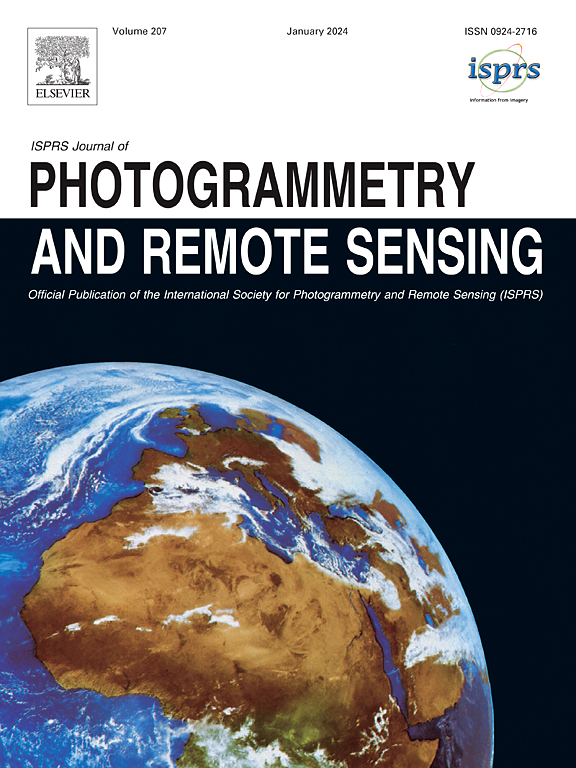4D RadarPR: Context-Aware 4D Radar Place Recognition in harsh scenarios
IF 10.6
1区 地球科学
Q1 GEOGRAPHY, PHYSICAL
ISPRS Journal of Photogrammetry and Remote Sensing
Pub Date : 2025-02-12
DOI:10.1016/j.isprsjprs.2025.01.033
引用次数: 0
Abstract
Place recognition is a fundamental technology for uncrewed systems such as robots and autonomous vehicles, enabling tasks like global localization and simultaneous localization and mapping (SLAM). Existing Place recognition technologies based on vision or LiDAR have made significant progress, but these sensors may degrade or fail in adverse conditions. 4D millimeter-wave radar offers strong resistance to particles like smoke, fog, rain, and snow, making it a promising option for robust scene perception and localization. Therefore, we explore the characteristics of 4D radar point clouds and propose a novel Context-Aware 4D Radar Place Recognition (4D RadarPR) method for adverse scenarios. Specifically, we first adopt a point-based feature extraction (PFE) module to capture raw point cloud information. On top of PFE, we propose a multi-scale context information fusion (MCIF) module to achieve local feature extraction at different scales and adaptive fusion. To capture global spatial relationships and integrate contextual information, the MCIF module introduces a fusion block based on multi-head cross-attention to combine point-wise features with local spatial features. Additionally, we explore the role of Radar Cross Section (RCS) information in enhancing the discriminability of descriptors and propose a local RCS relation-guided attention network to enhance local features before generating the global descriptor. Extensive experiments are conducted on in-house datasets and public datasets, covering various scenarios and including both long-range and short-range radar data. We compared the proposed method with several state-of-the-art approaches, including BevPlace++, LSP-Net, and Transloc4D, and achieved the best overall performance. Notably, on long-range radar data, our method achieved an average Recall@1 of 89.9%, outperforming the second-best method by 1.9%. Furthermore, our method demonstrated acceptable generalization ability across diverse scenarios, showcasing its robustness.
4D RadarPR:环境感知的4D雷达位置识别在恶劣的场景
位置识别是无人系统(如机器人和自动驾驶汽车)的一项基础技术,可以实现全球定位和同步定位和地图绘制(SLAM)等任务。现有的基于视觉或激光雷达的位置识别技术已经取得了重大进展,但这些传感器可能会在不利条件下退化或失效。4D毫米波雷达对烟雾,雾,雨和雪等颗粒具有很强的抵抗力,使其成为强大的场景感知和定位的有希望的选择。因此,我们探索了四维雷达点云的特征,并提出了一种新的针对不利场景的上下文感知四维雷达位置识别(4D RadarPR)方法。具体而言,我们首先采用基于点的特征提取(PFE)模块来捕获原始点云信息。在PFE的基础上,提出了一种多尺度上下文信息融合(MCIF)模块,实现了不同尺度的局部特征提取和自适应融合。为了捕获全局空间关系并整合上下文信息,MCIF模块引入了基于多头交叉注意的融合块,将点向特征与局部空间特征相结合。此外,我们探讨了雷达横截面(RCS)信息在增强描述符可分辨性中的作用,并提出了一个局部RCS关系引导的注意力网络,在生成全局描述符之前增强局部特征。在内部数据集和公共数据集上进行了广泛的实验,涵盖各种场景,包括远程和近程雷达数据。我们将所提出的方法与几种最先进的方法(包括bevplac++, LSP-Net和Transloc4D)进行了比较,并获得了最佳的整体性能。值得注意的是,在远程雷达数据上,我们的方法平均达到Recall@1 89.9%,比第二好的方法高出1.9%。此外,我们的方法在不同的场景下表现出可接受的泛化能力,显示了它的鲁棒性。
本文章由计算机程序翻译,如有差异,请以英文原文为准。
求助全文
约1分钟内获得全文
求助全文
来源期刊

ISPRS Journal of Photogrammetry and Remote Sensing
工程技术-成像科学与照相技术
CiteScore
21.00
自引率
6.30%
发文量
273
审稿时长
40 days
期刊介绍:
The ISPRS Journal of Photogrammetry and Remote Sensing (P&RS) serves as the official journal of the International Society for Photogrammetry and Remote Sensing (ISPRS). It acts as a platform for scientists and professionals worldwide who are involved in various disciplines that utilize photogrammetry, remote sensing, spatial information systems, computer vision, and related fields. The journal aims to facilitate communication and dissemination of advancements in these disciplines, while also acting as a comprehensive source of reference and archive.
P&RS endeavors to publish high-quality, peer-reviewed research papers that are preferably original and have not been published before. These papers can cover scientific/research, technological development, or application/practical aspects. Additionally, the journal welcomes papers that are based on presentations from ISPRS meetings, as long as they are considered significant contributions to the aforementioned fields.
In particular, P&RS encourages the submission of papers that are of broad scientific interest, showcase innovative applications (especially in emerging fields), have an interdisciplinary focus, discuss topics that have received limited attention in P&RS or related journals, or explore new directions in scientific or professional realms. It is preferred that theoretical papers include practical applications, while papers focusing on systems and applications should include a theoretical background.
 求助内容:
求助内容: 应助结果提醒方式:
应助结果提醒方式:


